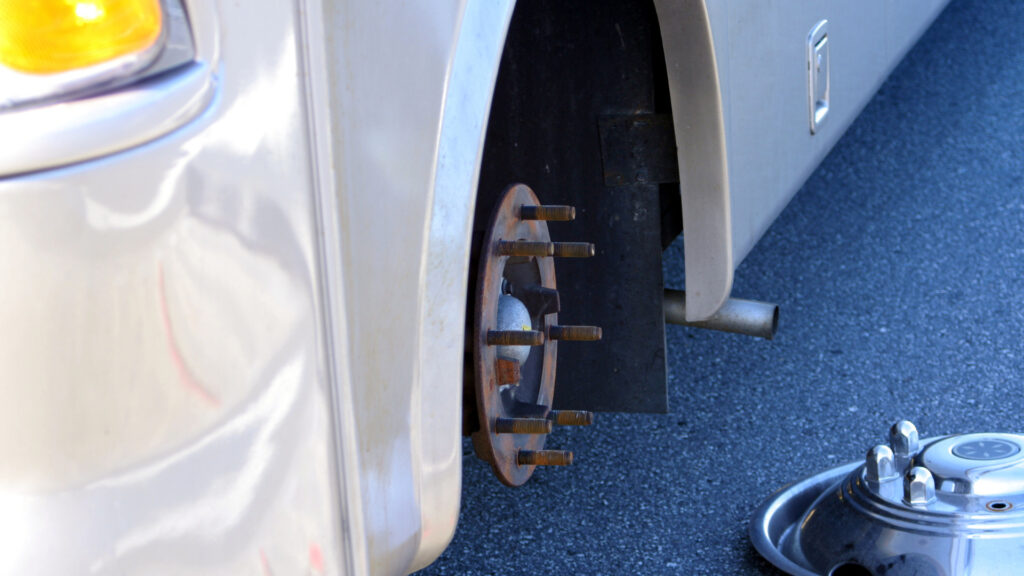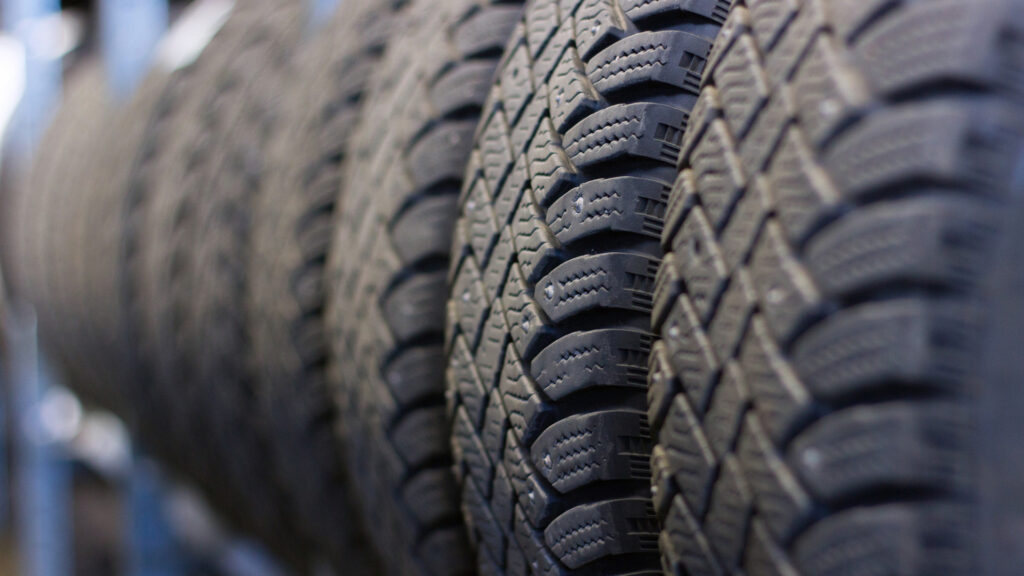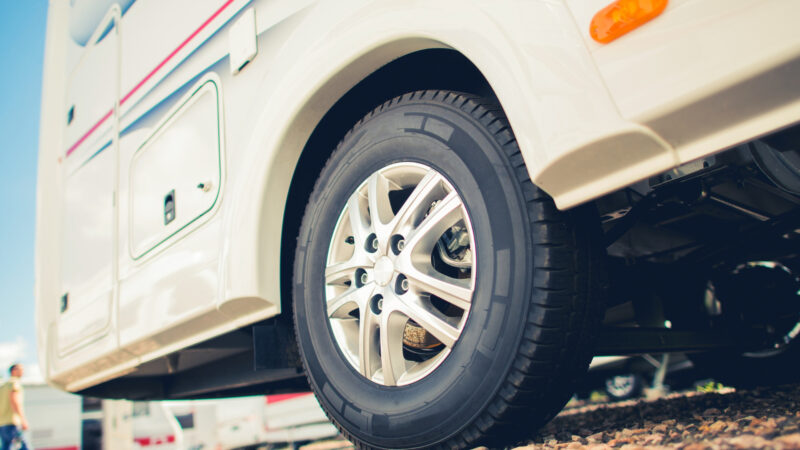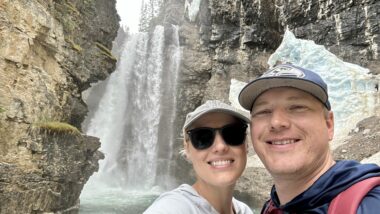Table of Contents Show
When you buy brand-new RV tires, you’d expect that after the installation, you can just drive away without worrying about anything.
Unfortunately, this isn’t always the case. You must check your tire pressure even after a brand-new set has been put on your RV.
Tires are expensive. Repairs are expensive. So you want to keep your chances of a blowout to a minimum.
Let’s look more at tire pressure, tire maintenance, and a few other important topics relating to RV tires!
What Are RV Tires?
Car manufacturers designed typical automobile tires with specific features to ensure long-lasting tread and safety for daily driving. They have flexible sidewalls because they help your vehicle’s steering and braking systems. They also transmit power from the drivetrain to the road.
This design differs a lot from trailer tires. RV tires don’t provide power from the drivetrain or steer your vehicle. Because they carry heavier loads, trailer tires help dissipate heat.
So although you might not be able to tell the difference by looking at a passenger car tire and a trailer tire, there are significant design differences.
What’s the Difference Between LT and ST Tires?
LT (light truck) tires are made for heavy vehicles. Class A and C motorhomes will have LT tires.
Some Class B camper vans may also have LT tires. The larger and heavier the motorhome, the beefier the tires need to be. Because these tires help steer and accelerate the RV, traction is really important.
ST (special trailer) tires handle trailer weights. These tires have a stronger sidewall than passenger car tires. Fifth wheels and travel trailers should have ST tires, not LT tires, because they aren’t steering or accelerating and don’t need the added traction. But they must have harder rubber compounds because of their heavy loads.
How to Read an RV Tire’s Sidewall
Because of the many letters and numbers, you may get confused by the tire’s sidewall. What do they all mean? The first two letters should be LT or ST to indicate the type of tire.
The following three numbers indicate the width of the tire in millimeters. For example, a tire that reads LT305/70R17 indicates a light truck tire measuring 305 millimeters in width.
The next set of numbers tells the height-to-width ratio, and the numbers after the “R” indicate the wheel diameter in inches. These numbers are important when choosing new RV tires. You want them to match the correct size for the load and size of your RV.
Along the top-left of the tire sidewall exists another vital piece of information. It tells you the load range of the tire with a letter. For example, a tire with a load range of H can handle up to 6,500 pounds of weight. Putting on new RV tires with the load range corresponding to the GVWR is crucial.
If your fifth wheel has a GVWR of 14,000 pounds, your tires shouldn’t have a load range of D because one tire can only carry 1,220 pounds. Four of those tires can only support 4,880 pounds together.
How Do I Know How Much Air Should Be in My RV Tires?
In smaller print near the center of the tire, you’ll find information about the tire pressure. This sits below the tire’s sidewall information about the width, diameter, and load rating.
You’ll see the maximum load capacity for the single tire as well as the inflation pressure when cold. Then you’ll find the same information for dual tires following it.
When checking your tire pressure, always check it cold. This means checking it before you drive. As you ride down the road, your tires heat up, and the temperature and pressure change. If the tire sidewall reads 50 PSI cold, your tires should all be at 50 PSI before leaving.
How Often Should I Check My Tire Pressure?
You should never travel anywhere without first checking your tire pressure. Even if you’ve only stayed one night at a Harvest Host, you should check your tire pressure before heading out in the morning. Keep in mind that altitude and temperature affect your tires.
Don’t be alarmed if you wake up and the two tires on the shaded right side of your RV read a certain PSI and the two tires on the left side of your RV, which caught the sun as it rose, read a different PSI. But always check the cold tire pressure before you do any driving.
How Often Should I Replace My RV Tires?
Although you can find guidelines for replacing RV tires, it’s hardly an exact science. How far you travel, where you travel, and your driving style all affect the longevity of your RV tires.
If you only drive 2,000 miles a year, you won’t have to replace your tires as often as a full-timer who travels 10,000 miles a year.
If you stick to mountainous terrain, you’ll likely have to replace your tires before someone who drives along flat, coastal highways.
In general, you should replace your tires after five years. On the tire’s sidewall, you’ll find the manufacturing date of the tire. Locate the Tire Identification Number (TIN). It starts with “DOT” followed by numbers and letters.
The last four numbers indicate the date of manufacture. For example, 4019 means your tires were manufactured in the 40th week of the year 2019.
Keep in Mind: Can You Look Up an RV by VIN Number? Let’s dive in and see.

Where Can I Buy New RV Tires?
RV tires are sold at several big box stores like Walmart, Costco, and Camping World. You don’t have to shop at a specialty store for quality RV tires. Amazon even sells tires.
You can also shop directly from a company like Michelin, Cooper, or Goodyear or locate a tire store nearby that carries a particular brand.
Why Is Weight Distribution Important?
You need to remember one thing about proper tire maintenance: how to load your RV. If you don’t balance your cargo well so that the weight is evenly distributed across the axle(s), you risk overloading a set of tires.
Although you may have the correct PSI, the correct load rating, and drive the recommended speed, you could experience a tire blowout.
Keep in Mind: Camper weight matters! See what the average weight is and why camper weight matters.
What Are China Bombs?
If you’ve been in the RV lifestyle for any length of time, you’ve likely heard of tires called “China bombs.” RVers often refer to the standard tires put on by the manufacturers as China bombs because they usually aren’t made of the same top-quality as other brands. They’re cheap alternatives.
Unfortunately, these lesser-quality tires often lead to tire blowouts. If you purchase a new RV and you don’t know the tire brand, you likely have China bombs, and you probably want to replace them as soon as possible.
For more information about China bombs, check out our article “Which RV Tires Are Considered “China Bombs”?
What Are Good Brands for RV Tires?
Many people find it stressful to choose new RV tires, Tires can also cost a lot. When buying new tires, you don’t want to break the bank, but you also don’t want to buy tires that increase your risk of a blowout.
Stick to brands like Goodyear, Michelin, Cooper, Bridgestone, and Continental. You’ll find them to be trusted names in the tire industry.
If you want more guidance, read our article “The Ultimate RV Tires Buyers Guide.”

Keep an Eye on Your Tire Pressure, Even After Buying New
Just because you have a new set of RV tires doesn’t mean you don’t need to properly care for them. Put on tire covers to protect them from the sun’s harmful rays.
Check the tire pressure before every trip. Evenly distribute the load inside your RV across the axle(s). All of these things will help prevent a tire blowout.
For more information about tire care and safe driving, check out these other articles:
Understand RV Tire Speed Ratings Before You Drive






